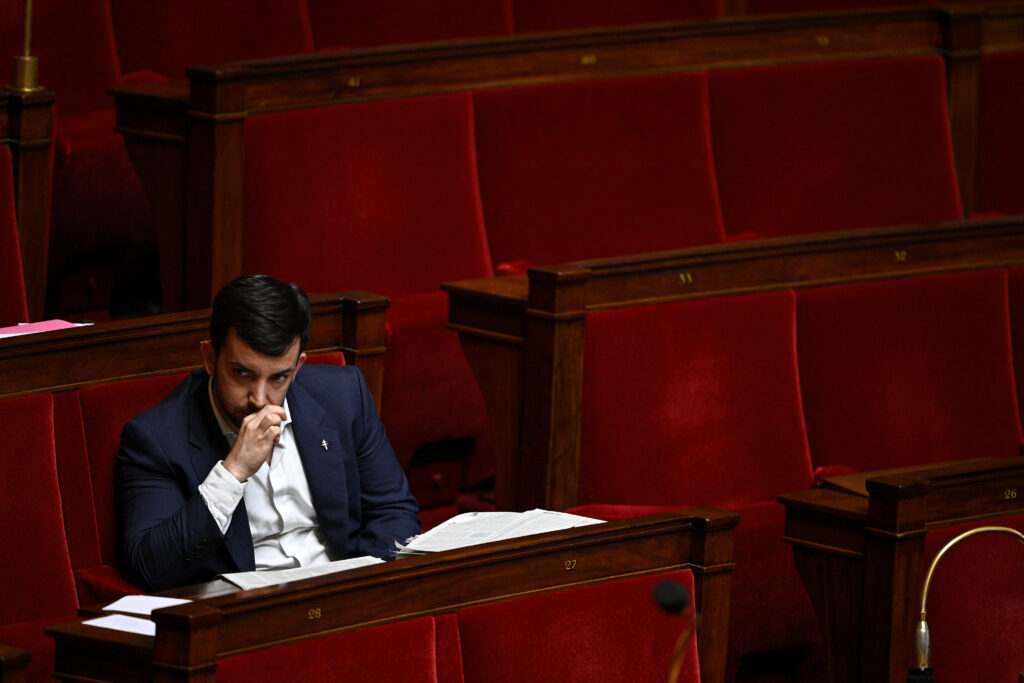Budget: le RN ne censurera pas s’il y a des baisses d’impôt et de dépenses (Tanguy)
Le Rassemblement national ne censurera pas le gouvernement Lecornu sur le budget si celui-ci comprend des baisses d’impôts et des baisses de dépenses, a assuré mardi le député Jean-Philippe Tanguy qui cependant n’y croit pas.”Si on fait ce qu’on demande, on ne censure pas pour censurer (…) Donc s’il y a des baisses d’impôts sur les classes moyennes et populaires, des baisses d’impôts sur ceux qui travaillent et des baisses de dépenses à côté, ce sera miraculeux”, a déclaré M. Tanguy sur TF1. Sébastien Lecornu a dit lors d’une réunion lundi avec ses alliés du “socle commun” que son futur gouvernement ferait des “propositions” de baisse d’impôts “notamment en faveur du travail et que “tout débat sur la fiscalité doit aller de pair avec la baisse réelle des dépenses publiques”.Mais M. Tanguy s’est dit “très pessimiste sur la capacité des macronistes de les réaliser (ces annonces) puisque chaque année ils nous font les mêmes promesses et chaque année les mêmes sales coups, à savoir finalement augmenter les impôts pour tout le monde et surtout ne jamais faire d’économies”. Depuis des semaines, le RN plaide inlassablement pour une nouvelle dissolution, ce qui le pousse à vouloir censurer le gouvernement Lecornu.Mais en ayant laissé entendre à l’avance cette censure, cela le met à l’écart des négociations et place au centre du jeu les socialistes dont les voix deviennent du coup indispensables au gouvernement Lecornu pour ne pas chuter. Une non-censure du RN permettrait cependant elle aussi le maintien du gouvernement.
Import-reliant Gabon gets taste for local beefTue, 30 Sep 2025 05:41:07 GMT
The rib eye steak that Matthieu Msellati was tucking into at a restaurant in Tchibanga in southwestern Gabon unusually came from a cattle ranch less than 50 kilometres (30 miles) away.Eating locally sourced food is still a rarity in the oil-rich central African country, which imports almost everything it eats but has a growing appetite …
Import-reliant Gabon gets taste for local beefTue, 30 Sep 2025 05:41:07 GMT Read More »
YouTube va verser 22 millions de dollars pour solder un contentieux avec Trump
YouTube a accepté de verser 22 millions de dollars pour mettre fin aux poursuites entamées par Donald Trump après la suspension de son compte par la filiale de Google, consécutive à l’assaut du Capitole le 6 janvier 2021, selon un document judiciaire publié lundi.Le site de vidéos en ligne est la dernière plateforme à s’entendre avec le président américain pour solder un contentieux entamé en juillet 2021, après Meta et X (ex-Twitter).Le président américain a posté une capture d’écran sur son réseau Truth Social saluant “une victoire MASSIVE” qui “prouve que la censure de la +Big Tech+ a des conséquences”. “YouTube CAPITULE!”, se félicite le message montrant un photomontage du président, tout sourire et pouce levé, recevoir un chèque des mains de Neal Mohan, le patron de la plateforme, dans les jardins de la Maison Blanche.Les avocats du chef de l’Etat ont indiqué que la somme serait reversée à un trust qui a notamment pour mission de financer la construction d’une gigantesque salle de bal à la Maison Blanche.Le 12 janvier 2021, YouTube avait suspendu le compte de Donald Trump au motif que l’ancien promoteur immobilier avait enfreint le règlement de la plateforme en appelant à contester physiquement le résultat du scrutin présidentiel de 2020.Le 6 janvier, des centaines de manifestants avaient pris d’assaut le Capitole pour protester contre l’homologation de la victoire de Joe Biden, un événement qui avait choqué les Etats-Unis et le monde et provoqué la mort de cinq personnes.YouTube n’avait rétabli le compte de Donald Trump qu’en mars 2023.- “Capitulation” -Également accusés par Donald Trump d’avoir injustement fermé son compte, Meta (Facebook) avait consenti fin janvier 2025 à s’acquitter de 21 millions de dollars pour éviter un procès, imité, quelques semaines plus tard, par X, à hauteur de 10 millions.La filiale de Google, qui appartient lui-même au groupe Alphabet, n’a reconnu aucun tort et ne s’est pas engagée à une action corrective.Elle s’évite ainsi un procès, dont la date n’avait pas encore été fixée.L’observatoire des médias Media Matters voit dans la décision de YouTube une “capitulation honteuse et de courte vue”.”Se soumettre sans raison maintenant revient à encourager Trump et ses efforts visant à étouffer les voies dissidentes en mettant au pas les médias et les plateformes en ligne”, a ajouté Angelo Carusone, le président de cette association classée à gauche.- La série continue -De nombreux juristes ont en effet estimé, depuis l’assignation, que les arguments juridiques de Donald Trump étaient insuffisants pour envisager une décision favorable au président devant un tribunal.YouTube, Meta ou X étant des entreprises privées, disaient-ils, rien ne les empêche de réguler le contenu qui est publié ou non sur leurs plateformes, ce principe primant sur celui d’une possible atteint à la liberté d’expression.Outre Meta et X, la transaction avec YouTube intervient après des accords amiables entre le président américain et plusieurs groupes de médias poursuivis par Donald Trump.En juillet, CBS s’est engagé à débourser 16 millions de dollars pour clore une procédure liée à une interview de l’ancienne candidate démocrate à la présidence des États-Unis, Kamala Harris, en pleine campagne.Donald Trump reprochait à la chaîne d’avoir édité un passage de l’entretien dans lequel l’ex-vice-présidente répondait de façon “incohérente”.En décembre, ABC, déjà, avait accepté de régler un autre contentieux aussi initié par le milliardaire républicain, en déboursant 15 millions de dollars.Dans le cadre du compromis de lundi, qui doit encore être validé par une juge fédérale d’Oakland en Californie, YouTube va également payer 2,5 millions de dollars à d’autres titulaires de comptes également suspendus après les événements du 6 janvier.Figurent notamment parmi eux les personnalités conservatrices Austen Fletcher et Naomi Wolf, qui relaient régulièrement des théories conspirationnistes.
C1: Mourinho à Chelsea, un retour tellement “spécial”
José Mourinho revient mardi (21h00) avec Benfica à Stamford Bridge, le stade de Chelsea où le “Special One” a forgé sa réputation d’entraîneur bouillant et enrichi son palmarès de géant, sans n’y garder que des amis pourtant.”Je fais partie de leur histoire et ils font partie de la mienne. Je les ai aidés à devenir un plus grand Chelsea et ils m’ont aidé à devenir un plus grand José”, a-t-il lancé lundi en conférence de presse.C’est dans la peau du petit Poucet et avec ses meilleures années derrière lui que le Portugais de 62 ans retrouve les Blues de Londres, ses anciens protégés, pour la deuxième journée de Ligue des champions.”Mou” a débarqué dans la capitale britannique en juillet 2004 avec la réputation d’un jeune quadragénaire brillant, tout juste sacré dans la grande coupe d’Europe avec Porto.Et déjà, ce côté provocateur qui lui colle à la peau: “S’il vous plait, ne dîtes pas que je suis arrogant car ce que je dis est vrai: je suis champion d’Europe (…) et je pense être quelqu’un de spécial”.Le “Special One” est né, le ton est donné et les trophées ne tardent pas à arriver.Chelsea n’avait pas gagné le championnat depuis 1955? Il le remporte deux fois de suite, d’entrée en 2005 et 2006, au nez et à la barbe du Manchester United d’Alex Ferguson, le club hégémonique de la décennie.Son équipe empile les records dès sa première saison en Premier League, et certains tiennent encore: aucune défaite à domicile, seulement 15 buts encaissés dont 9 à l’extérieur, 25 “clean sheets” (matches sans prendre de but) en 38 journées.- “Judas? Je reste le N.1” -Bref, Mourinho remet Chelsea au centre du village, sportivement et médiatiquement parlant. Car le Portugais ne fait pas que gagner, il provoque et alimente les polémiques, il s’emporte contre les arbitres, l’UEFA ou Arsène Wenger, l’entraîneur d’Arsenal.C’est une véritable star, que ses supporters adulent et que les adversaires détestent.Or, cette double face se retourne contre lui quand il revient au Bridge, en 2007 avec Manchester United. Une partie du public se retourne contre celui qui a raflé au total sept titres nationaux (trois en championnat, trois en Coupe de la Ligue et un en Coupe d’Angleterre) et dirigé plus de 320 matches durant deux mandats (2004-2007 puis 2013-2015).Certains supporters chantent “Tu n’es plus Special!” ou le traitent de “Judas”. Lui réplique: “Jusqu’à ce qu’ils trouvent un entraîneur qui va leur gagner quatre championnats, je reste le N.1. Quand ils trouveront ce manager, alors je serai le N.2. En attendant, Judas est le N.1.”Lundi, il a préféré rire de ces épisodes passés. “Je ne pense pas que les supporters de Chelsea vont me huer. En tout cas, dans la rue, ce sont eux qui me dérangent tout le temps pour des photos et des autographes”, a-t-il glissé dans un sourire.Mourinho est en tout cas littéralement chez lui, à Londres, puisque sa famille réside toujours dans la capitale britannique.- “Aucune pression” -Mardi, il tentera de déjouer les pronostics avec Benfica, qu’il n’a rejoint que très récemment. Ses trois premiers matches à la tête des Aigles n’ont pas été spécialement convaincants, notamment la courte victoire de vendredi contre Gil Vicente (2-1), mais il demeure invaincu.Le Chelsea d’Enzo Maresca, à l’inverse, sort d’un mois de septembre sans victoire en championnat (un nul puis deux défaites) et avec une défaite contre le Bayern Munich en Ligue des champions.”Nous devons rester positifs”, a martelé l’entraîneur lundi face aux médias. En réalité, “il n’y a aucune pression” actuellement si ce n’est “celle que nous connaissons: quand on est entraîneur à Chelsea, il faut gagner des matches”.L’Italien a précisé qu’Andrey Santos, Moises Caicedo et Joao Pedro étaient incertains, en plus des forfaits de Wesley Fofana, Liam Delap et Cole Palmer entre autres.Tous les ingrédients pour un coup de “Mou”?
Ligue des champions: l’Ajax en plein doute au moment d’affronter l’OM
Un fond de jeu “inexistant”, un coach en sursis, une équipe encore traumatisée par une fin de saison précédente catastrophique: l’Ajax est en plein doute au moment de se déplacer mardi à Marseille en Ligue des champions.Battus à domicile par l’Inter Milan (0-2) en match d’ouverture, les Ajacides sont d’autant plus sous pression pour cette 2e journée de la phase de ligue, que les critiques pleuvent après un début de saison laborieux en Eredivisie.Samedi, Davy Klaassen et ses coéquipiers se sont offert un peu de répit en venant difficilement à bout du NAC Breda (2-1) pour se positionner en troisième position d’un championnat dominé par le Feyenoord Rotterdam de Robin van Persie. Cette victoire à l’arraché n’a toutefois pas rassuré les supporters: le stade Johan Cruyff a copieusement sifflé ses joueurs à la fin de rencontre.En cause, le spectacle guère emballant offert par leurs favoris depuis le début de la saison.”L’Ajax n’a pas été très impressionnant cette saison et contre le NAC Breda, l’équipe a vraiment touché le fond. C’était dramatique, un fond de jeu inexistant”, a fustigé l’ancien joueur Pierre Van Hooijdonk, analyste notamment pour le magazine spécialisé Voetbal International.”Owen Wijndal et Anton Gaaei, qui n’étaient pas jugés assez bons ces dernières années, sont aujourd’hui titulaires. Cela en dit long sur le manque de qualité de l’effectif, non ?”, a-t-il encore asséné.Pour comprendre le courroux des fans, il faut remonter à la fin de saison passée quand l’Ajax, alors en tête du championnat avec un large avantage de 11 points à cinq journées de la fin, s’est effondré, laissant le titre promis s’échapper au profit du PSV Eindhoven.- En panne d’attaquants -Le scénario dramatique de cette fin d’exercice avait coûté sa place au coach Francesco Farioli, arrivé de l’OGC Nice à l’intersaison.Il avait été reproché à l’Italien un football trop défensif peu en phase avec la philosophie de football total jadis de mise, dans ce club où la tradition d’un 4-3-3 offensif n’est pas un vain mot.Pour le remplacer, les dirigeants amstellodamois ont fait appel à un ancien de la maison, Johnny Heintiga, jusque-là adjoint de son compatriote Arne Slot à Liverpool.Mais la greffe ne prend pas. “Johnny est un type formidable, mais cela ne fonctionne pas”, a commenté Rafael van der Vaart, consultant TV et ancien équipier d’Heitinga en équipe nationale. Et de souligner: “Face à Breda, il y a eu la victoire mais ce fut très mauvais et l’Ajax aurait très bien pu s’incliner 6-2”.Un autre ancien du club, Ibrahim Afellay embraye: “Certains joueurs n’évoluent pas à leur place. Par exemple, Klaassen qui est un numéro 6, est aligné comme meneur de jeu. Ça ne va pas”.A la décharge d’Heitinga, il a souvent dû se passer d’un véritable buteur. Wout Weghorst a ainsi souvent été blessé et alors qu’il était espéré à Marseille, il ne figure finalement pas dans le groupe retenu. “Ce match vient un peu tôt pour lui”, a déclaré lundi le technicien néerlandais.Quant au Danois Kasper Dolberg, arrivé le dernier jour du mercato en provenance d’Anderlecht et accueilli comme le messie pour son retour dans un club qui l’avait révélé entre 2015 et 2019, il est lui aussi sur le flanc pour des pépins physiques.L’OM rencontre donc l’Ajax sans doute au meilleur moment, sachant que le programme à venir du club néerlandais ne sera pas ‘une promenade de santé: Sparta Rotterdam, AZ Alkmaar, Chelsea, Twente, Heerenveen et Galatasaray. Pas sûr qu’Heitinga y survive…
Ligue des champions: le Real Madrid aux portes de la Chine, les fans aux anges
“Je suis surexcitée!”: Rebecca Feng jubile avant d’embarquer à Pékin pour le Kazakhstan, où le Real Madrid joue mardi, rare opportunité pour les Chinois d’assister à un match de Ligue des champions pas (trop) loin de chez eux.Maillot blanc de Kylian Mbappé sur le dos, elle trépigne à l’aéroport en pensant au match qui aura lieu à Almaty, la plus grande ville kazakhstanaise, entre la modeste équipe locale du FC Kaïrat et les stars madrilènes.Si le voyage est long pour le Real Madrid, qui a fait une dizaine d’heures d’avion pour rejoindre le pays d’Asie centrale, la venue du club espagnol fait le délice des supporters asiatiques.Car au lieu de parcourir 7.000 voire 9.000 kilomètres pour rejoindre l’Europe, un vol de quelques heures suffit pour goûter à la Ligue des champions. Le Kazakhstan est frontalier avec la Chine. De Pékin à Almaty, il faut environ cinq heures de vol.”En plus, les Chinois n’ont pas besoin de visa pour le Kazakhstan et le match tombe la veille” de huit jours fériés, “donc il suffisait de poser un jour de congé”, explique à l’AFP Rebecca Feng.”C’était un alignement de planètes parfait (…) Une occasion à ne pas manquer!”, souligne la jeune femme de 28 ans, enveloppée dans un drapeau frappé du logo du club.- Souvenir d’enfance -Au total, au moins 30 membres de ChinaReal, le fan-club chinois du Real Madrid, devraient faire le déplacement depuis la Chine, selon Peng Fei, le président de la branche shanghaïenne de l’association.Sur les réseaux sociaux, des dizaines d’internautes de Shanghai ou d’Urumqi, grande ville chinoise la plus proche de la frontière du Kazakhstan, ont affirmé se rendre à Almaty pour le match.Bien que situé en Asie, le Kazakhstan est membre de l’UEFA depuis 2002. C’est seulement la deuxième fois qu’un club national dispute la Ligue des champions, après le FC Astana.Fan du Real et de Sergio Ramos depuis la victoire de l’Espagne à l’Euro-2008, Rebecca Feng a découvert le club madrilène chez son grand-père où “la télévision était toujours allumée sur la chaîne sport”.”Quand j’étais étudiante en Espagne, j’étais allée à deux matches au Bernabeu”, explique la jeune femme, qui travaille dans la finance.A ses côtés, Alex Lee, 25 ans et admirateur de Cristiano Ronaldo, ancien du Real, piétine d’impatience avant d’embarquer dans l’avion. “J’ai un bon pote, fan de Jude Bellingham, qui devait venir avec moi, mais il n’a pas pu se libérer à cause de son travail. Donc il m’a donné son maillot du joueur pour que je le porte et que je le représente au match”, dit-il.- “Très disputés” -Le stade du Kaïrat ne compte qu’environ 23.000 places. Les billets pour la rencontre ont donc été “très disputés”, notamment car “des fans de toute l’Asie centrale étaient intéressés”, assure Rebecca Feng.C’est grâce à ChinaReal qu’elle a pu obtenir des places dans les tribunes visiteurs, à 50 euros pièce, raconte-t-elle. “Ce sera super d’être avec tous les autres supporters, dont ceux venus d’Espagne”, s’enthousiasme-t-elle.Les deux prévoient de faire du tourisme au Kazakhstan, avec une escapade en Ouzbékistan voisin pour Rebecca Feng.Leurs attentes pour le match?”Le Real vient de perdre le derby madrilène contre l’Atlético (5-2 samedi, NDLR). Alors j’espère qu’ils vont se remettre d’aplomb!”, affirme Rebecca Feng.”J’adore (l’international uruguyen) Federico Valverde, pour sa combativité. Je suis impatient de le voir en vrai!”, indique Alex Lee, qui se risque à un pronostic: “3-0 pour Real, avec des buts de Mbappé et Bellingham!”






